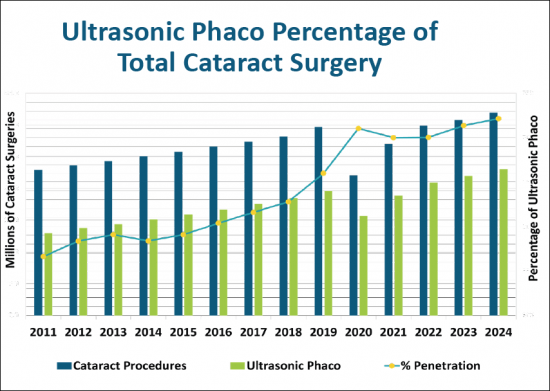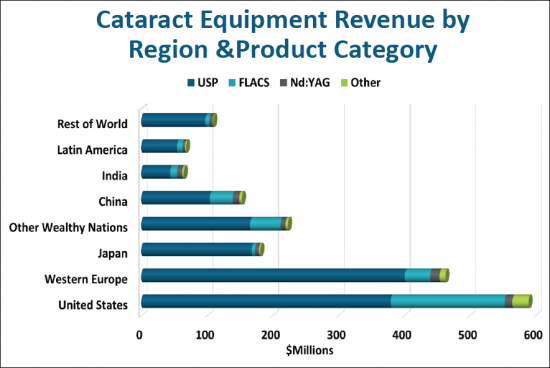
|
市場調査レポート
商品コード
1486552
白内障手術機器の世界市場(2024年):2023年~2029年の分析2024 Cataract Surgical Equipment Market Report: Global Analysis for 2023 to 2029 |
||||||
|
|||||||
| 白内障手術機器の世界市場(2024年):2023年~2029年の分析 |
|
出版日: 2024年06月12日
発行: Market Scope, LLC
ページ情報: 英文
納期: 即日から翌営業日
|
- 全表示
- 概要
- 目次
白内障手術機器市場では、2024年初頭にCarl ZeissがDORCを、RaynerがSophiを買収し、買収した2社の世界のマーケティング展開によって市場の土俵が変わるとみられています。
当レポートでは、白内障手術機器市場について調査し、市場規模や成長動向とともに、超音波フェイコーマシン、パック、アクセサリー、フェムトセカンドレーザー支援白内障手術システム、光ディスラプターレーザーなどのセグメント別の動向、製品需要、市場シェアの製品カテゴリー別に分析し、さらに、競合21社のプロファイルなどをまとめています。
当レポートでは、2024年の白内障機器市場の収益のうち10億米ドル以上が消耗品からもたらされると徹底的に調査しています。消耗品は、ASCRSやESCRSなどの団体が環境の持続可能性の取り組みでますますターゲットにしています。レポートには、白内障手術用の使い捨て製品の課題と、今後数年間の市場への予想される影響について取り上げた新しいセクションが含まれています。
当レポートでは、2024年初頭に予定されているCarl ZeissによるDORCの買収とRaynerによるSophiの買収についても分析し、買収企業2社の世界のマーケティング力によって市場の競争環境が変化すると予測し、これら2つの買収が市場に与える影響を予測しています。
また、Centricity ZeptoやCarl ZeissのmiLoopおよびmiCorなどの介入型白内障手術装置に関する新しいセクションが含まれています。レポートでは、miCorフェイコハンドピースの発売予定について説明し、この新製品の機会と展望(新しい市場収益源であることから、従来の超音波フェイココンソールに提示される課題まで)を取り上げています。さらに、FLACS市場の現状と、世界のすべての地域でFLACSの成長を促進するために必要な変更についての新たな詳細な分析も取り上げています。
Market Scopeが実施した新たな評価の結果、フェイコ機器の年間売上推定値と設置ベースが変更されました。
サンプル


当レポートは、世界の白内障手術機器市場を詳細に分析し、市場の規模と成長を検証するとともに、市場の将来を形作る可能性のある重要な開発を特定しています。この分析は2024年の市場に焦点を当て、2029年までの成長と進化を予測しています。製品の需要は数量とドルで予測され、市場シェアは製品カテゴリ別に分析されています。さらに、21社の競合他社のプロファイルが示され、各社の製品、戦略的市場ポジション、背景、および見通しについて説明されています。
目次
- 世界の白内障罹患率と白内障手術に関する情報
- 世界の白内障手術件数の現在の推定と5年予測
- 老眼、屈折異常、屈折レンズ交換術に関する考察
- 米国の白内障および白内障/屈折矯正外科医のプロファイル
- 企業の手術プロバイダーに関する情報
- 現在の診療報酬水準の検討
- フェイコーマシンおよびフェムトセカンドレーザー支援白内障手術装置の説明と考察
- 白内障手術機器メーカーと市場シェアの分析
- フェイコパックとアクセサリーの市場調査
- 光破壊レーザー市場に関する情報
What's New:
The "2024 Cataract Surgical Equipment Market Report" thoroughly examines the over $1 billion of cataract equipment market revenue in 2024 that will come from consumables-which are increasingly targeted by groups such as the ASCRS and ESCRS in their environmental sustainability efforts. The report includes a new section that addresses the challenge to disposable products for cataract surgery and its expected impact on the market in the coming years.
The report also analyzes acquisitions of DORC by Carl Zeiss and Sophi by Rayner in early 2024 that change the market playing field, thanks to the global marketing reach of the two acquiring companies, and estimates the impact of these two acquisitions on the market.
This coverage includes a new section on interventional cataract surgical devices, including the Centricity Zepto and Carl Zeiss' miLoop and miCor. The report discusses the expected launch of the miCor phaco handpiece and addresses the opportunity and outlook of this new product-from being a new market revenue stream to the challenges it presents to traditional ultrasonic phaco consoles.
Also featured is a new deep dive into the current state of the FLACS market, and the changes needed to stimulate FLACS growth in all regions of the world.
Additionally, the annual sales estimates and installed base for phaco machines have been resized as a result of a new evaluation performed by Market Scope.
SAMPLE VIEW


The "2024 Cataract Surgical Equipment Market Report" provides in-depth analysis of the global cataract surgical equipment market, examining the market's size and growth, as well as identifying important developments that may shape its future. Product coverage includes ultrasonic phaco machines, packs, and accessories; femtosecond laser-assisted cataract surgery systems; and photodisruptor lasers.
The analysis focuses on the 2024 market and forecasts growth and evolution through 2029. Product demand is forecast in units and dollars, and market shares are analyzed by product category. Additionally, 21 competitors are profiled, with discussion of their products, strategic market position, background, and outlook.
Contents:
The "2024 Cataract Surgical Equipment Market Report" includes:
- Information on cataract incidence and cataract surgeries worldwide.
- Current estimates and five-year forecasts for global cataract surgery volume.
- Discussion of presbyopia, refractive errors, and refractive lens exchange procedures.
- Profiles of cataract and cataract/refractive surgeons in the US.
- Information about corporate surgery providers.
- Examination of current reimbursement levels.
- Descriptions and discussion of phaco machines and femtosecond laser-assisted cataract surgery equipment.
- Analysis of cataract surgical device manufacturers and market share.
- Examination of markets for phaco packs and accessories.
- Information on the market for photodisruptor lasers.
Author Profile:
William Freeman
Bill Freeman has more than 35 years of experience developing, manufacturing, and marketing cataract surgery products. He has held key executive positions at four firms that produce ophthalmic surgical devices.
Bill's career in ophthalmology began in the 1970s. As president of Cavitron Surgical Systems, he worked with Dr. Charles Kelman in developing and marketing the world's first phacoemulsifier system. While highly controversial in the 1970s, phacoemulsification gradually became the preferred cataract removal technique in the early 1980s. For many years, Cavitron led the cataract instrumentation market.
CooperVision purchased Cavitron in the early 1980s, and Bill joined the company as president of the surgical division. CooperVision expanded its product line to include a wide variety of cataract surgical products-IOLs, viscoelastic solutions, disposable devices, lasers, and custom packs-and became the market leader in many product categories.
In 1989, Alcon acquired CooperVision in an effort to build a strong presence in cataract surgical devices. Bill joined Alcon as general manager of the Irvine Technology Center, where a number of the company's cataract devices, including the Legacy 20000 phacoemulsifier and a broad line of disposable items, were designed and manufactured.
Bill remained with Alcon until 1995. He then joined Mentor Ophthalmics as president of the ophthalmology division. At Mentor, he was responsible for the company's ophthalmic products including IOLs, cautery devices, and surgical instruments.


